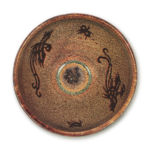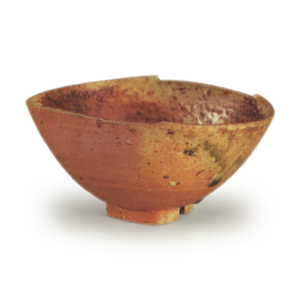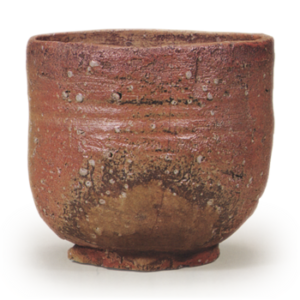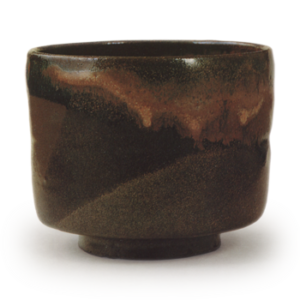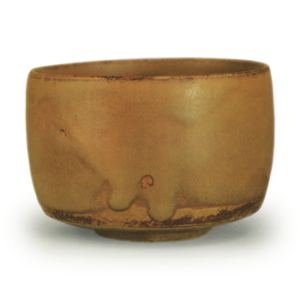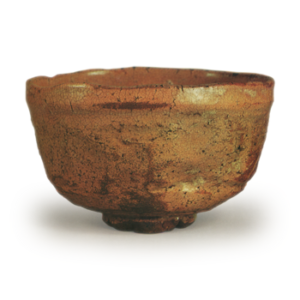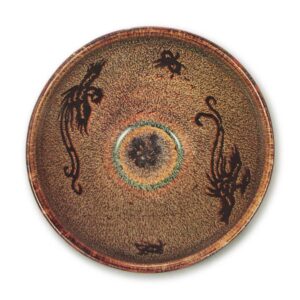
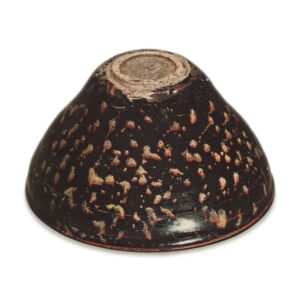
Chuko Meibutsu
Height: 7.0cm
Diameter: 12.7cm
Height of foot ring: 3.7cm
Height of rim: 0.2cm
Among the tea bowls that have been handed down through the generations, this is a famous bowl that has been highly regarded since ancient times, along with the Chinese floral pattern that was passed down through the generations of the Matsudaira Fumai family, the dragon pattern with jewels that was passed down through the generations of the Fujita family, and the plum blossom pattern that was passed down through the generations of the Maeda family. According to the “Meibutsu-ki” (famous tea bowls),
Taihagai, owned by Tsuchiya Samon, 2.4 cm in height, but including the incense burner, the mouth (diameter) is 4.15 cm, the incense burner is 1.8 cm, and the handle is 1.5 cm. The handle has a plum blossom design. with gold inlay, box-shaped lid, plain paper cover, gold powder maki-e, sand-grained back, chrysanthemum design on lid, “Taihate Tenmoku” inscription, as shown on the right, with a chrysanthemum design on the Tenmoku stand
made of blue shell , but the accompanying item as shown on the right also exists.
Of the inherited Minkawa-gai tea bowls, this is the one with the deepest bowl, and the shape of the waist, which is a little more slender, is not seen in many others.
The rim of the mouth is slightly turned outwards, and the outside is covered with shallow potter’s marks. The slightly reddish white clay is characteristic of the Yoshishu Mempigai, but the foot ring is rather roughly carved, and the carving from the foot ring to the waist is distinctive.
The interior The center of the front has a six-petal flower pattern, and the sides have a phoenix and a butterfly-like insect pattern, but the patterns are drawn with a lot of space left in between, so they fit together in a very elegant composition.
The glaze is double-glazed, as is usual for this type of teapot, and the pattern on the inside is black, with a pearlescent base. The color of the pearlescent glaze is a beautiful mixture of blue and red. As the black underglaze is not covered by the glaze on the rim, it has a red, tortoiseshell-like, rice-grain pattern, like a border.
The outside also has a honey-colored glaze with a pattern of small and large spots in the shape of a hearth. The glaze is rich in variety, both inside and out, and the scenery is rich and well-melted with a luster.
The inner box is black lacquered, with the rim finished in powdered rice flour, and the characters for “Taihata Tenmoku” are in gold powder. style is Enshu-fu, but the calligrapher is unknown.
The accompanying Tenmoku stand is a black lacquered Chinese stand with a chrysanthemum branch design inlaid with blue shell, green and dark red stones, and is probably from the late Ming period.
It is said to have been in the possession of Tsuchiya Sagami no Kami, but its history before that is unclear. According to the “Tsuchiya Family Ledger”, it was given to the Kuchiki clan by the Tsuchiya family in 1792, and then passed to the Akaboshi family in Tokyo after the Meiji period. According to the Tsuchiya Family Archives, it was given by the Tsuchiya family to the Kutsuki clan in 1792, and then passed to the Akaboshi family in Tokyo after the Meiji Restoration. In June 1917, it was sold at auction for 80,000 yen to Eisaku Masuda, and was in the collection of Hiroshi Masuda when it was included in the Taisho Meiki Kan (A Guide to Famous Taisho-era Works). It then passed to the Muromachi Mitsui family, and is still in their possession today.
(Hayashi

